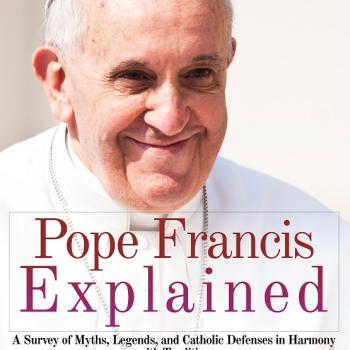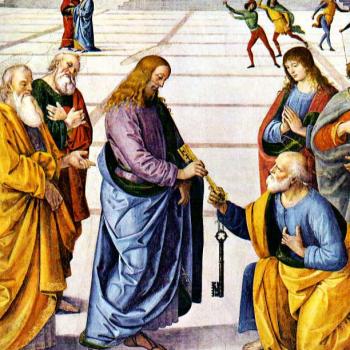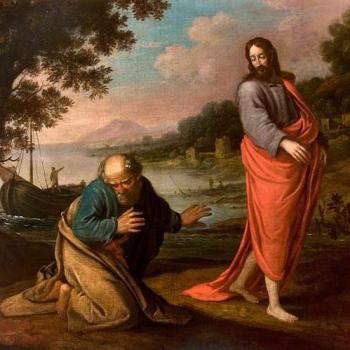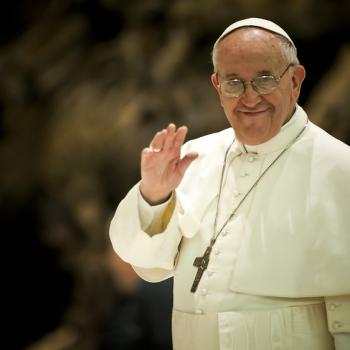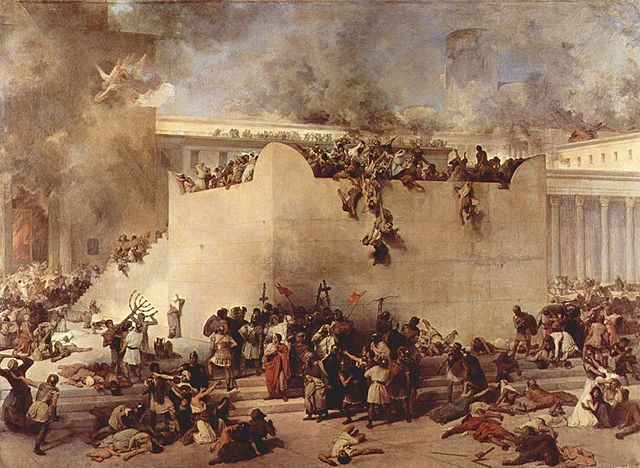
Neither the Church nor the pope can fall away from the faith. It’s never yet happened in 2000 years, and will not. This is the doctrine of indefectibility.
Catholics believe in the indefectibility of the Church, which includes the pope, on a biblical basis, as well as a traditional one. St. Robert Bellarmine (in teaching that was reiterated by the First Vatican Council in 1870) taught that the pope could never bind the faithful to heresy; that it would and could never happen.
Yet, lo and behold, today we hear a growing loud, relentless, chorus of naysaying, faith-challenged folks who seem to think this can happen. We have people like Phil Lawler (who studied political philosophy in college and later became a prominent Catholic journalist), author of the upcoming book, Lost Shepherd: How Pope Francis is Misleading His Flock, stating in its Introduction:
I did my best to provide assurance—for my readers and sometimes for myself—that despite his sometimes alarming remarks, Francis was not a radical, was not leading the Church away from the ancient sources of the Faith. But gradually, reluctantly, I came to the conclusion that he was. . . .
I found I could no longer pretend that Francis was merely offering a novel interpretation of Catholic doctrine. No, it was more than that. He was engaged in a deliberate effort to change what the Church teaches.
What exactly is Lawler claiming? What teaching of the Church is Pope Francis supposedly going to change? Well, we don’t know for sure yet. The book comes out next February 26th. I’m quoting these portions from the glowing review given to the book by Catholic apologist and one of the fathers of the modern apologetics movement (and my good friend), Karl Keating.
Most critics of the pope center upon Amoris Laetitia. Lawler is reluctant to say that it espouses heresy. But he claims that it “is not a revolutionary document. It is a subversive one. Francis has not overthrown the traditional teaching of the Church, as many Catholics hoped or feared that he would.” Ah, I see. Keating goes on to presumably describe how Lawler reasoned through to this conclusion:
The document gives wide pastoral latitude, enough so that, in practice, in certain areas the traditional teaching of the Church can be set aside while not being denied.
Lawler opines: “Pope Francis has not taught heresy, but the confusion he has stirred up has destabilized the universal Church.” We’ll have to see the full reasoning (or facsimile thereof) when the book comes out, but at first glance, this sure looks to me like the classic reactionary mindset of what I have described as “quasi-defectibility.”
It’s been used by radical Catholic reactionaries (see the definition of that category, which is different from traditionalists) for at least fifty years, particularly with regard to Vatican II, but also recent popes, and the Pauline (ordinary form) Mass.
The idea is that an ecumenical council and popes supposedly espoused something akin to a defection from traditional teaching, but not quite. Purveyors of this dangerous notion get right up to claims concerning the cliff and abyss of heresy and then draw back. It’s the ambiguity and fog of uncertainty that is key, you see. I’ve been closely studying and refuting the arguments of radical Catholic reactionaries for over twenty-five years, and have written two books about them. I wrote about quasi-defectibility five years ago:
I have used the term “quasi-defectibility” to describe the far more radical position of holding that the Church is still the Church, but in very dire condition and barely surviving. I’ve always agreed (closely following my mentor, Fr. John A. Hardon, S. J.) that modernism is the greatest crisis in the history of the Church. Disagreement with radical Catholic reactionaries (and “traditionalists” to some extent, depending on the person) occurs regarding its exact cause and location, and the solutions to the problem.
And also as far back as 2000:
[It’s] another attempt to have it both ways, to be ambiguous and nebulous, just as Vatican II is accused of being. . . . validity is a moot point within the overall context of the radical skepticism and lack of faith (acceptance of quasi-defectibility or literal defection) of reactionaries.
In a similar way, I described the views of Catholic muckraker and sensationalistic journalist Michael Voris, in one of his innumerable videos four years ago:
This exhibits an alarming lack of faith and hope, which is highly characteristic of the modernists within the Church and also Protestants who attack the Church.
For Voris, only a tiny bit of the Catholic Church (“small remnant”) is even left. Extreme language abounds. Truth and goodness in the Church? “Almost none” is left, so he informs us, because “those first principles are gone.” . . .
Voris is not asserting defectibility, but at some point, the more pessimistic we are about the Church and her state, it can become, in some respects, a sort of “quasi-defectibility” outlook. . . .
So Voris and his many thousands of followers don’t see anything positive around them to highlight? All they can do is moan and groan and complain about the Church, and if anyone points that out, they have their head in the sand and are pretending that everything is perfect (as if that’s ever been the case at any time in the history of the Church)?
Voris is not just pointing out failings. He seems to think there is barely any Church left. It’s the same as always: if we don’t learn from history, we’re doomed to repeat it: the same old dangerous errors recycled again for our time. People love the gloom-and-doom message. For the life of me, I don’t know why, but something in human nature resonates with that.
I haven’t claimed that Voris is leading people into schism (someone on my Facebook page thought that I did). He’s the one who talks about a “Church within a Church,” etc. I think he’ll lead many people to despair, however, if he keeps this up, . . .
Voris wasn’t even talking about Pope Francis. But this same mentality and faith-challenged, anxiety-laden mindset has been regurgitated yet again in our times, with regard to Pope Francis. We’re now literally to the point of widespread rampant tin foil hat conspiratorialism and virtual paranoia and hysteria.
I dealt with this sort of thing in my (originally 2002) book, Reflections on Radical Catholic Reactionaries. Nothing is new under the sun. The sort of attitudes now widely observed were taking place back then, when we had a saint as pope. They were simply confined almost exclusively to reactionaries and many traditionalists as well. Now they are rapidly branching out to those not in either camp: regular orthodox Catholics: well-meaning, sincere, but choosing to go down this wrong and destructive path.
I hope to dissuade them from it, for their own good and the good of the Church and unity and an effective witness to the dying world, but my voice is but a soft whisper compared to the avalanche of anti-Francis rhetoric now taking place every day. For some reason, people love the negative, pessimistic, despairing, “o woe is us!” outlook more than the positive, optimistic, hope-filled way of life and vision. I’ve never understood that, but it is a fact of life.
If Phil Lawler is claiming that Pope Francis is going to overturn an actual dogma of the Church, that’s an assertion of defectibility: a thing that has never happened in the history of the Church, and which faithful Catholics believe never would or could happen. I think he’s sharp enough to realize the utterly radical, alarming nature of that claim, and so he steps back and adopts the reactionary tactic of quasi-defectibility: allowing him to have it both ways, and talk out of two sides of his mouth. He can sound the alarm and play the prophet (like Voris, Sungenis, Ferrara, The Remnant, 1 Peter 5, Lifesite News, Rorate Caeli, the reactionary-dominated Correctio, and others have been doing) about how terrible things are without — like Gandalf — going over the hopeless cliff of defectibility.
But (note this closely): if the Church hasn’t defected, it hasn’t! Not A = Not A. Basic logic. If Pope Francis indeed hasn’t, and/or won’t, cause the Church to depart from any of her magisterial teaching, where’s the beef? Lawler has undercut the very heart of his alarmist “case” by refusing to assert a coming defectibility. It’s simply good ol’ reactionary doublethink and hysteria yet again: that does no one any good.
I thought it might be interesting to some of my readers, to see that I critiqued the essential nature of what is going on today, in chapter three of my 2002 book, entitled, “The Indefectibility of the Church” (again: “nothing new under the sun” as Ecclesiastes states). Most of my reasoning was directed against the reactionary attacks on Vatican II and the New Mass, but it fits perfectly into the “anti-Francis” mentality today. I did, however, allude to the attacks back then against Pope St. John Paul II, in #75 and #77. Chapters 13 and 15 of the book (about 22 pages total) were devoted to savage, slanderous attacks on Pope St. John Paul II, as well as Blessed Pope Paul VI and Pope St. John XXIII. Here it is:
III. The Indefectibility of the Church
- Many radical Catholic reactionaries believe that the “bitter fruits” of Vatican II have all but “destroyed” the Church. This is “quasi-defectibility.” The reactionary rarely – in mixed company — wants to assert this outright (according to their incessant doublethink), but how close they habitually come! It becomes an Orwellian situation wherein the Church can’t defect, yet it can come so close that the observer is tempted to opine that it is a distinction without a difference. Meanwhile, some reactionary pessimists continue their exodus from the “middle position” (relatively speaking) to the more logically consistent but less orthodox formally schismatic positions of sedevacantism and other similar groups. Faithful Catholics believe that God will not let the Church in any way, shape, or form be “destroyed.”
- G. K. Chesterton observed:
At least five times, . . . with the Arian and the Albigensian, with the Humanist sceptic, after Voltaire and after Darwin, the Faith has to all appearance gone to the dogs. In each of these five cases it was the dog that died. (The Everlasting Man, Garden City, New York: Doubleday Image, 1925, 254)
- History offers ample illustration that the heretics always eventually disappear, or at least greatly diminish in influence. The Church will survive. In fact, the beginning signs of coming revival are plain already, if one would simply maintain a little hope and optimistic faith that God is in control.
- The present crisis is the most serious the Church has ever faced, per Pope St. Pius X’s summation of the evils of modernism. At the same time (in contrast to reactionaries), orthodox Catholics remain total optimists as to eventual outcome — through faith, reading the signs of the times and of positive developments, and the knowledge of previous crises in Church history. We vehemently deny that the Church has defected or has been taken over by the forces of evil, and all the other pessimistic, scandalous, and pathetic scenarios that reactionaries suggest concerning causes of the crisis and institutional demise, “auto-demolition,” etc.
- Reactionaries think that the Church will eventually wake up and abandon the great “liberal experiment” of Vatican II. But this is the atrocious and exceedingly un-Catholic belief that a validly convoked ecumenical council, ratified by a pope, could be so heretical as to necessitate “abandonment,” as if we were talking about the Robber Council of 449. This is defectibility and nonsense — a pure hybrid of a certain strain of a-historical Protestantism and “Catholic” liberalism.
- The Church, we are told, has institutionally defected (or almost so). Never before (so reactionaries claim) has rampant (institutionalized, proclaimed) error run roughshod over orthodoxy for so many years after a council. Obviously, then, according to reactionaries, the Church is in dire straits. As in the view of Martin Luther, the Church has descended into darkness, and brave prophets have now been raised to bring it back to life. Luther seemed to think of himself as some sort of prophet-figure, too. As reactionaries seem to follow his example in many other ways, why not this one, also?
- Reactionaries contend with a straight face that the Church has collapsed, apparently mainly because of the New Mass, ecumenism, and religious liberty. If they want to see a real collapse, they should go look at the various liberalized Protestant denominations, such as the Episcopalians or the United Church of Christ. Even the Orthodox (who pride themselves on their strict traditionalism and immunity from modernism) accept contraception and divorce. One can’t fail to note the striking contrast. All these groups have institutionalized theological errors and immorality, and now – in some instances — call evil good, and heresy, orthodoxy. I don’t think reactionaries have the slightest inkling of what real “near-spiritual death” looks like.
- Obviously, modernism has filtered down to reactionaries also, since they are so pessimistic about the Church, just like the most liberal, skeptical German higher critics of the 19th century. They doubt the council; they doubt the pope. The Church is practically in shambles; almost in the grips of Antichrist himself . . . What better success could the modernists achieve than to get a committed, devout Catholic to doubt those things, even while he bashes the modernists who have assisted in the promulgation of such loss of belief (though not through the council itself)?! The entire reactionary argument about the virtual downfall of the Church is based on a subjective house of cards. Once logic and consistency are introduced to it, it collapses. It has more holes in it than a pin cushion. The opposing view is based on objective facts of Church history, and the analogy of earlier councils and crises (following Newman’s methodology in his Essay on the Development of Christian Doctrine). Pre-conciliar authorities and popes express views diametrically opposed to those espoused by reactionaries.
- “Auto-demolition” is a favorite reactionary expression for the alleged institutional demise of the Church. Yet is this term applied to any other troubled period of Church history? It is not. Since the Church always revived itself from very deep pits of decadence and heretical outbreaks in the past, according to the principle of indefectibility and the guidance of the Holy Spirit, it obviously would make no sense to do so. But as many reactionaries apparently aren’t sure of the outcome of this crisis, seemingly lacking faith in God’s designs in the worst of circumstances (we call that providence and sovereignty in theology), they utilize a phrase that would be patently ludicrous in other historical circumstances. Malcolm Muggeridge wrote about “The Great Liberal Death Wish.” I guess many reactionaries believe that Christ’s own Church — His Body — is rapidly committing suicide as well. How sad . . .
- If the council and popes are positively promulgating “grave” heretical error, then surely the Satanic conspiracy to overthrow the Church is complete, and the “gates of hell” have prevailed against the Church, contrary to our Lord’s promises (Matthew 16:18). This would, of course, raise further thorny difficulties for orthodox Christology.
- We need not start believing that the Church has self-destructed now because of the modernist crisis, since it isn’t much worse than the Arian crisis, or the “Reformation” crisis, or the Great Schism, or the rupture of 1054, or recurring periods of moral decadence.
- G. K. Chesterton:
I suspect that we should find several occasions when Christendom was thus to all appearance hollowed out from within by doubt and indifference, so that only the old Christian shell stood as the pagan shell had stood so long. But the difference is that in every such case, the sons were fanatical for the faith where the fathers had been slack about it. This is obvious in the case of the transition from the Renaissance to the Counter-Reformation. It is obvious in the case of a transition from the eighteenth century to the many Catholic revivals of our own time . . . Just as some might have thought the Church simply a part of the Roman Empire, so others later might have thought the Church only a part of the Dark Ages. The Dark Ages ended as the Empire had ended; and the Church should have departed with them, if she had been also one of the shades of night. (The Everlasting Man, Garden City, New York: Doubleday Image, 1925, 250-252)
- The liberal frowns upon the institutional Church. The Protestant denies that the One True Church “subsists” in the Catholic Church, or re-defines it as invisible. The quasi-schismatic reactionary believes that the Catholic Church could somehow collapse institutionally (just as many historically sophisticated Protestants think was the case with the late medieval Catholic Church).
- Do reactionaries think that God will condemn anyone for having too much faith in His Church and His protection of it from error and defection into heresy?
***
Photo credit: The destruction of the Temple of Jerusalem (1867) [in 70 A. D.], by Francesco Hayez (1791-1882) [public domain / Wikimedia Commons]
***




